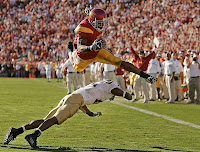
This post isn't particularly related to athletes (although it could be tailored as such), but more for the general fitness enthusiasts in the crowd.
While working at SAPT the other day, I retrieved the mail and I found a magazine in it which got me thinking.
It had a caption on the cover reading:
"Sexy Arms, Perky Butt, FIRM ABS, And More....How the Stars Get' Em!"
- "6-Pack Abs, FAST!"
- "The SECRET to rapid fat loss, Finally revealed!"
- "A routine for bigger biceps that actually works! (Details on pg. X)"
- "Finally, an EASY method to build the body you've always been waiting for!"
You want to know the secret behind these things? I know the answer. I can tell you the cliff notes answer of every SECRET hiding behind the magazine covers (and every future magazine, BTW). The secret behind achieving that body you've always wanted. All you have to do is exactly follow the directions below.
Ready? Here are the 9 simple steps.
- Eat whole, unprocessed foods.
- Avoid sugar like the bubonic plague.
- Drink more water.
- Avoid drinks containing more than zero calories (this leaves you with options such as water, green tea, coffee).
- Move around more than you currently do.
- Pick up heavy things (with good form).
- Carry heavy things (with good form).
- Perform other compound movements such as rows, pushups, and lunge variations (with good form..noticing a pattern here?)....
- Repeat this for 50 years.
But people don't like to hear this. Why? it implies the necessity to refuse to make excuses for laziness and to actually make a conscious effort - on a daily basis - to take care of one's body.
Believe it or not, developing a body that feels good, looks good, and performs well actually takes consistent effort. For years. But the magazines don't want you to know this (otherwise they'll go out of business!).
Understand that magazines live or die by the slogan "Publish or Perish." Quite simply, they have to produce something on the shelves that is going to sell. So they're always promising the latest and greatest way to lose fat, build muscle, blah blah blah....
It's all the same, just re-packaged in fancy wrapping with shiny colors.
And people will eat this stuff up like candy because they're always looking for something that relieves them of the duty to work hard on a regular basis.
At SAPT, we have a mom who trains with us on a regular basis despite the fact that she's fighting breast cancer. We have a 16-year old girl with a severe foot injury (out for the basketball season) who is training with her foot in a boot and rolling around with that foot propped on a stroller. We have a man who is training with a torn rotator cuff. We have adults training with us that have full-time jobs, and also have to run multiple kids around to sport practice, tutoring sessions, friend's houses, etc. yet they still make time to take care of their bodies.
These are the people that "get it." They know what the Secret is.
There are many, many other similar situations like these, as well, that I'll save for the sake of brevity.
Eating healthy and exercising doesn't have to be this terrible process, either. In fact, once I learned how to cook DELICIOUS meals that were going to provide a positive change in my body, I've never wanted to go back to eating like garbage. Eating healthy doesn't mean chicken and steamed broccoli and/or a salad all the time, either.
Don't enjoy exercising or are unsure of what to do once you enter the gym? Hire a coach to point you in the right direction, or work out in a small group (like the training structure we have set up at SAPT) to keep you motivated and keep things FUN!
Now go get after it! (And don't let me catch you peeking in the magazines).























